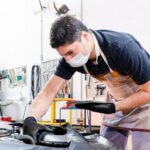When it comes to maintaining or restoring your car’s appearance, automotive paint is a key player. Whether you’re repairing a scratch or giving your ride a brand-new look, knowing the ins and outs of automotive paint is essential. In this article, we’ll cover everything you need to know, from the different types of paints available to the best techniques for application.
What Is Automotive Paint?
Automotive paint is specifically designed to coat and protect vehicles, offering both aesthetic appeal and a layer of defense against the elements. It’s not just about picking a color—it’s a combination of science and artistry to ensure your car stays looking sleek and protected for years.
Why Does Automotive Paint Matter?
A car’s paint job is more than just a pretty exterior. Sure, it boosts visual appeal, but did you know it also protects your vehicle from rust, corrosion, and even UV rays? Automotive paint creates a protective barrier, reducing the risk of long-term damage caused by weather and road conditions.
Whether you’re a DIY enthusiast or planning to hire a professional, understanding automotive paint can help you make informed decisions when it comes to car maintenance.
Types of Automotive Paint
There’s a lot more to automotive paint than meets the eye. The type of paint you choose can make or break the durability and finish of your vehicle’s exterior. Let’s dive into the most common types of automotive paint available.
1. Acrylic Paints
Acrylic paints are popular due to their affordability and ease of application. They’re water-based and often used for touch-ups or small repairs.
- Advantages: Easy to apply and cost-effective.
- Disadvantages: Not as durable as other options and may require frequent touch-ups.
2. Enamel Paints
Enamel paints are more durable than acrylic paints and are solvent-based. They offer a hard, glossy finish that can last for years if properly maintained.
- Advantages: Long-lasting and provides a hard finish.
- Disadvantages: Takes longer to dry and can be challenging for beginners to apply.
3. Urethane Paints
Urethane paints are the gold standard for automotive paint jobs. They are durable, resistant to fading, and offer excellent protection against weathering.
- Advantages: Extremely durable, resistant to UV rays, and maintains a glossy finish.
- Disadvantages: Expensive and requires more skill to apply.
4. Base Coat/Clear Coat Systems
This system involves applying a color base coat followed by a clear coat for protection. The clear coat adds shine and depth while protecting the paint from environmental elements.
- Advantages: High-gloss finish with added protection.
- Disadvantages: Requires multiple layers, making the process more time-consuming.
The Automotive Paint Process: Step-by-Step
Applying automotive paint isn’t as simple as grabbing a brush and painting away. Here’s a breakdown of the process for achieving a showroom-quality finish.
1. Preparation
Preparation is key! This step involves cleaning the surface, sanding it down, and masking off areas that shouldn’t be painted.
- Tip: Use fine-grit sandpaper for a smooth surface.
2. Primer Application
Primer ensures the paint adheres properly to the surface. It also provides a smooth base for the topcoat, covering imperfections.
- Tip: Apply 2-3 coats of primer and allow it to dry thoroughly between coats.
3. Base Coat Application
The base coat provides the actual color. Depending on the paint type, you may need to apply multiple layers to achieve the desired finish.
- Tip: Thin, even coats are your best bet for a smooth finish.
4. Clear Coat Application
The clear coat acts as a protective layer and gives the paint its glossy appearance. This step is essential for ensuring durability and shine.
- Tip: Allow sufficient drying time between coats to avoid a sticky finish.
5. Buffing and Polishing
Once the paint and clear coat have dried, it’s time to buff and polish the surface for that high-gloss, mirror-like finish.
- Tip: Use a microfiber cloth for buffing to avoid scratches.
Common Issues with Automotive Paint (and How to Avoid Them)
Even with the best intentions, things can go wrong during the painting process. Here are some common issues you might face and how to avoid them.
1. Orange Peel Effect
This refers to a textured surface that resembles an orange peel. It’s usually caused by improper spraying techniques or not allowing enough drying time between coats.
- Solution: Sand the surface and apply another clear coat to smooth it out.
2. Paint Drips
Too much paint in one area can cause unsightly drips.
- Solution: Use light, even strokes when applying the paint.
3. Cracking or Peeling
This happens when the paint hasn’t properly adhered to the surface or when different types of paint are incompatible.
- Solution: Always follow the manufacturer’s guidelines for compatibility and preparation.
The Importance of Proper Equipment
You might be wondering, “Do I really need all this gear to paint my car?” The answer is yes! Investing in the right equipment can make a world of difference in the quality of your paint job.
Must-Have Tools:
- Spray Gun: Ensures even paint distribution.
- Air Compressor: Necessary for powering the spray gun.
- Protective Gear: Safety first! Use gloves, goggles, and a mask to avoid inhaling fumes.
- Sanding Blocks: For smoothing the surface before and after painting.
Frequently Asked Questions (FAQs)
- How long does automotive paint last? With proper care and maintenance, automotive paint can last anywhere from 5 to 10 years.
- Can I apply automotive paint myself? Yes, but it requires patience and the right tools. If you’re new to painting, consider practicing on a smaller area first.
- How much does it cost to paint a car? Costs can vary depending on the paint type and labor. On average, a professional paint job can range from $500 to $5,000.
- What’s the best way to maintain automotive paint? Regular washing, waxing, and avoiding harsh weather conditions will help maintain your paint’s shine and durability.
- Can I paint over existing automotive paint? Yes, but you’ll need to sand the surface and apply a primer before adding a new layer of paint.
Conclusion
Automotive paint isn’t just about aesthetics; it’s a crucial part of your vehicle’s overall protection. Whether you’re sprucing up an old car or keeping a new one looking sharp, understanding the different types of paint and the proper application process is vital. Armed with this knowledge, you’ll be able to make informed decisions about your car’s paint job and avoid costly mistakes.
Don’t forget, if you’re unsure about tackling this project yourself, hiring a professional can save you time and ensure a flawless finish. Whatever route you choose, keeping your car’s exterior in top shape is always a smart investment!







